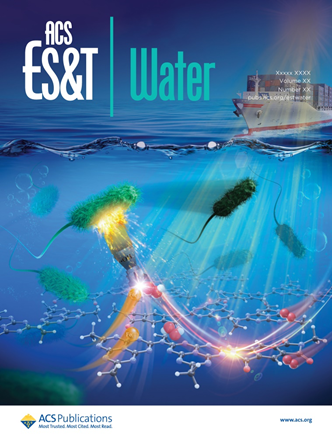近日,广东工业大学环境健康与污染控制研究院、环境科学与工程学院王万军教授和硕士生谢皓晶等人在光催化/芬顿原位耦合体系灭活典型压舱水病原微生物的机理研究方面取得最新研究进展,研究成果以《Visible Light-Induced Marine Bacterial Inactivation in Seawater by an In SituPhoto-Fenton System without Additional Oxidants: Implications for Ballast Water Sterilization》为题发表在ACS ES&T Water杂志上(https://pubs.acs.org/doi/10.1021/acsestwater.1c00048),并被选为内封面论文。该工作首次构建了无外加氧化剂的光催化/芬顿原位耦合体系,实现了在可见光下对压舱水中海洋细菌的高效杀灭,系统阐明了海洋细菌灭活机理及其对海洋生态系统的影响。
压舱水排放造成的外源微生物入侵对海洋环境构成了严重威胁。然而目前针对压舱水消毒的高级氧化技术(如UV/Fenton等)需要外加化学氧化剂(如H2O2)或者紫外光照,造成成本上升,不利于环境可持续发展。这项研究首次建立了无外加氧化剂的光催化/芬顿原位耦合系统用于压舱水消毒。该系统利用均苯四酸二亚胺(PDI)改性的g-C3N4作为光催化剂在天然海水中合成H2O2,并被水中Fe(II)原位活化产生•OH实现对海洋病原菌的灭活。压舱水的典型病原菌——溶藻弧菌(7 log)可在35分钟可见光照内被完全灭活。通过对H2O2合成量和细菌灭活效率的同步原位监测,阐明了光催化-芬顿的原位耦合机理,发现经芬顿活化后产生的•OH是主要灭菌反应活性物种。本文详细探讨了溶藻弧菌在灭活过程中的生理生态变化,探明了细胞膜破裂、细胞内酶活性和总蛋白质变化方面的细菌灭活机理。通过三维荧光技术研究了细菌裂解过程中的胞内有机物释放特征及降解机制,开展的急性毒性实验表明有机质及其降解中间体的毒性极小,不会对海洋生态环境造成不利影响。该研究不仅为船舶压舱水消毒提供了一种仅利用太阳能的无外加氧化剂高效灭菌方法,而且为探索海洋病原菌的灭活机制提供了新的研究思路。
论文的网址:https://pubs.acs.org/doi/10.1021/acsestwater.1c00048
论文封面:

ABSTRACT
Harmful non-indigenous microorganism invasion caused by ballast water discharge poses severe threats to marine environments. In this study, a conceptual in situ photo-Fenton system without additional oxidants was first established for ballast water sterilization. Pyromellitic acid diimine (PDI)-modified g-C3N4 was utilized as a photocatalyst to produce H2O2, which was in-situ activated by Fe(II) to produce •OH for deep oxidation. Marine bacterium Vibrio alginolyticus (7 log) in ballast seawater was totally inactivated within 35 min of visible light irradiation. Simultaneous bacterial inactivation and H2O2 production was monitored to confirm the in situ coupling mechanism, and •OH instead of H2O2 was determined to be the dominant reactive species. The influence of seawater parameters, such as salinity, pH, and dissolved oxygen, on the inactivation efficiency was revealed. In addition, the bacterial inactivation mechanisms in terms of cell membrane rupture, intracellular enzyme activity, and total protein change were clarified. The organic matter release profile during bacterial lysis was probed by fluorescence excitation−emission matrix technology, which revealed minimal acute toxicity and impacts on the marine environment. This work not only advances an external oxidant-free system for on-board ballast water sterilization using sustainable solar energy but also creates an avenue for exploring bacterial inactivation mechanisms in seawater.